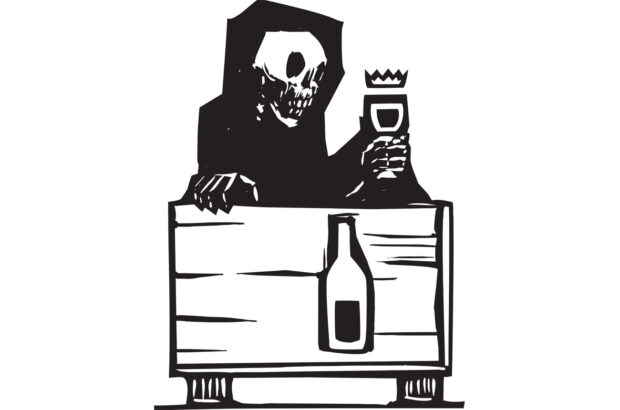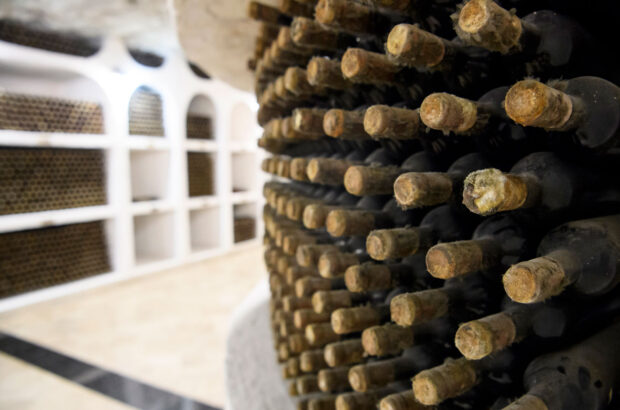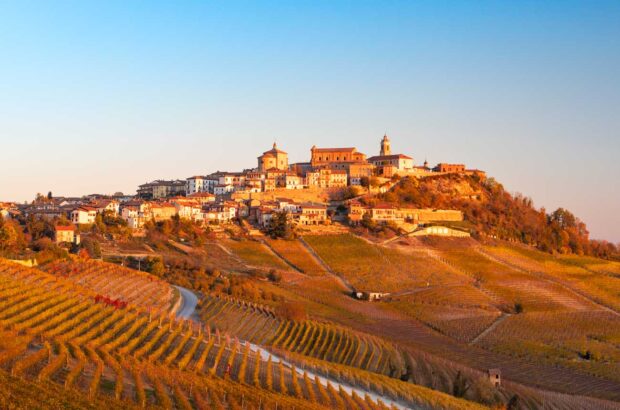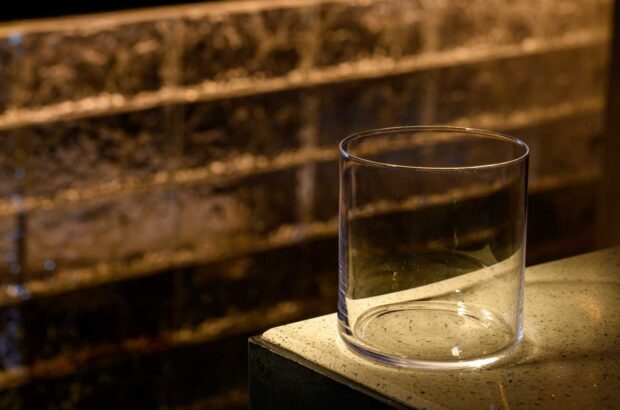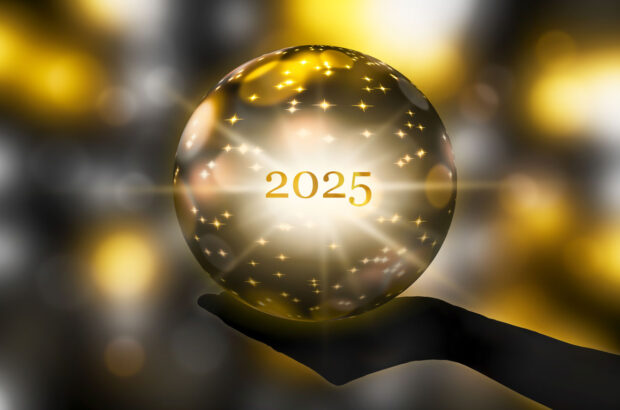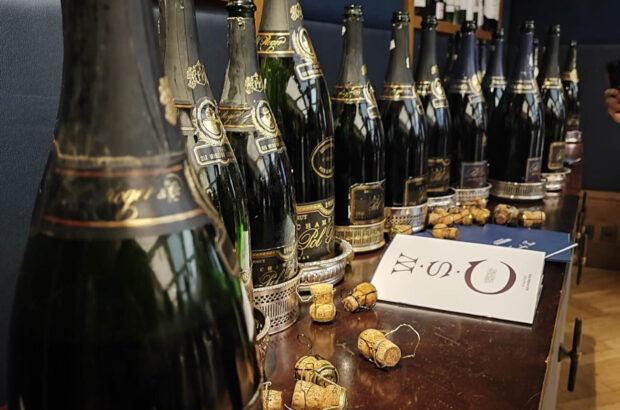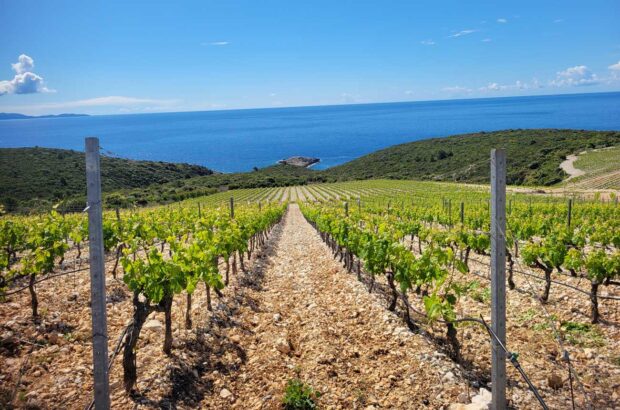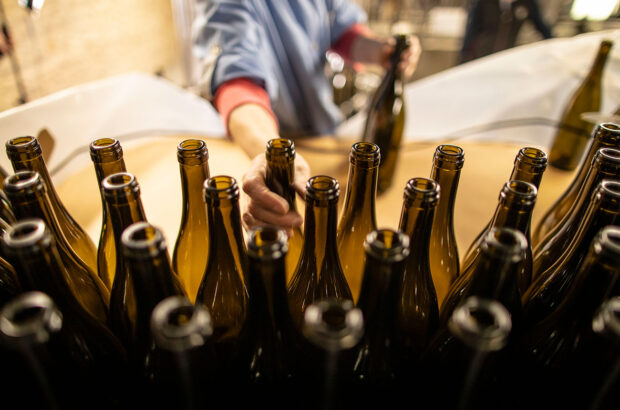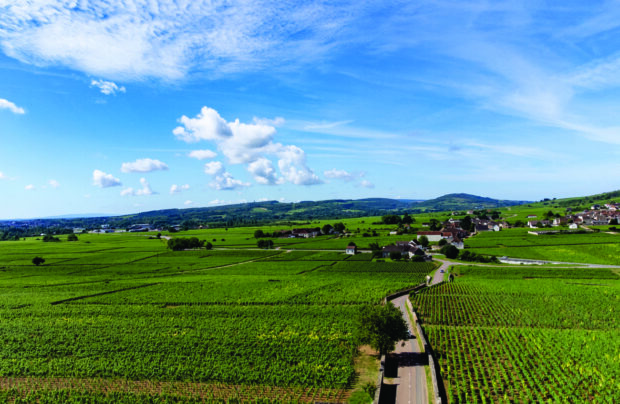Many people associate the rise of Bordeaux en primeur with the legendary 1982 vintage. However, selling Bordeaux wine en primeur – while the new wines are still ageing in barrel, potentially many months prior to their bottling and release – boasts a storied history, dating all the way back to the 1740s.
By the early 20th century, it had become a significant event in Bordeaux, with frenzied autumnal ‘campaigns’ taking place among prestigious châteaux and Bordeaux négociants. However, it wasn’t until the 1950s that the practice began to evolve into its modern form.
Today, ‘EP’ as it’s known, remains an important way to buy Bordeaux wine ‘futures’, often as a form of investment.
For the producers, it’s a hedging tool that reduces price volatility and secures cashflow. How this all started helps to explain the forces that will continue to affect EP and its prices.
As The Wine Society’s long-serving buyer, now retired, Sebastian Payne MW tells me, this history has ‘all to do with money, of course, or lack of it’.
{"content":"PC9wPgo8aDI+MTk1MHMgJmFtcDsgMTk2MHM6IEJvb20gdGltZXMgYmVnaW4gaW4gQW1lcmljYTwvaDI+CjxwPlRoZSBwaWVjZXMgb2YgdGhlIOKAmHdpbmUgZnV0dXJlc+KAmSBwdXp6bGUgYmVnYW4gdG8gZmFsbCBpbnRvIHBsYWNlIGFmdGVyIFdvcmxkIFdhciBJSS4gQm90aCBGcmFuY2UgYW5kIEJyaXRhaW4gd2Fsa2VkIGEgc2xvdyBwYXRoIHRvIGVjb25vbWljIHJlY292ZXJ5LiBJbiB0aGUgVVMsIGJ5IGNvbnRyYXN0LCBwZW9wbGUgcmV2ZWxsZWQgaW4gdGhlIOKAmGpldCBzZXTigJkgZXJhIHdoaWNoIHNhdyBNYW5oYXR0YW5pdGVzIHNpcHBpbmcgPHN0cm9uZz48YSBocmVmPSJodHRwczovL3d3dy5kZWNhbnRlci5jb20vcHJlbWl1bS9wcm9kdWNlci1wcm9maWxlLXBldHJ1cy1wb21lcm9sLWJvcmRlYXV4LTM3NDcyNC8iIHRhcmdldD0iX2JsYW5rIiByZWw9Im5vb3BlbmVyIG5vcmVmZXJyZXIiPlBldHJ1czwvYT4gPC9zdHJvbmc+UG9tZXJvbCBhdCB0cmVuZHkgcmVzdGF1cmFudHMgc3VjaCBhcyBMZSBQYXZpbGxvbi48L3A+CjxwPkl0cyBvd25lciBib3VnaHQgd2VsbC1wcmljZWQgRVAgY2xhcmV0IGZyb20gUm9iZXJ0IEhhYXMgKHBpY3R1cmVkIGJlbG93KSwgd2hvIHdvcmtlZCBhdCB0aGUgUGFyayBBdmVudWUgd2luZSBzdG9yZSBNIExlaG1hbm4gKGFuZCB3b3VsZCBnbyBvbiB0byBjby1mb3VuZCBUYWJsYXMgQ3JlZWsgVmluZXlhcmQgaW4gUGFzbyBSb2JsZXMsIGluIDE5ODkpLjwvcD4KPGRpdiBjbGFzcz0iYWQtY29udGFpbmVyIGFkLWNvbnRhaW5lci0tbW9iaWxlIj48ZGl2IGlkPSJwb3N0LWlubGluZS0zIiBjbGFzcz0iaXBjLWFkdmVydCI+PC9kaXY+PC9kaXY+CjxwPkluIDE5NTQsIEhhYXMgdG9vayBoaXMgZmlyc3QgYnV5aW5nIHRyaXAgdG8gRnJhbmNlLiBEdWUgdG8gdGhlIGxlYW4gZWNvbm9taWMgdGltZXMsIHdpbmVzIGZyb20gdGhlIDE5NTIgdmludGFnZSByZW1haW5lZCBhdmFpbGFibGUgaW4gYmFycmVsLiBIYWFzIGhhZCBhbiBlcGlwaGFueTogc2VsbCB0aGUg4oCZNTJzIHRvIGhpcyBzZWxlY3QgY3VzdG9tZXJzIGluIGFkdmFuY2UuIEhlIGNob3NlIHdlbGwuPC9wPgo8cD5FYXJseSBpbiAxOTU1LCBjaMOidGVhdXggPGEgaHJlZj0iaHR0cHM6Ly93d3cuZGVjYW50ZXIuY29tL3dpbmUvcHJvZHVjZXItcHJvZmlsZXMvY2hhdGVhdS1jaGV2YWwtYmxhbmMtcHJvZHVjZXItcHJvZmlsZS0yODA4OTgvIiB0YXJnZXQ9Il9ibGFuayIgcmVsPSJub29wZW5lciBub3JlZmVycmVyIj48c3Ryb25nPkNoZXZhbCBCbGFuYzwvc3Ryb25nPjwvYT4sIDxzdHJvbmc+PGEgaHJlZj0iaHR0cHM6Ly93d3cuZGVjYW50ZXIuY29tL3dpbmUvcHJvZHVjZXItcHJvZmlsZXMvY2hhdGVhdS1sYWZpdGUtcm90aHNjaGlsZC02ODY5MS8iIHRhcmdldD0iX2JsYW5rIiByZWw9Im5vb3BlbmVyIG5vcmVmZXJyZXIiPkxhZml0ZSBSb3Roc2NoaWxkPC9hPjwvc3Ryb25nPiwgPGEgaHJlZj0iaHR0cHM6Ly93d3cuZGVjYW50ZXIuY29tL2ZlYXR1cmVzL2NoYXRlYXUtbGF0b3VyLWFuLWF1Y3Rpb24tcHJvZmlsZS0yNDgzNDgvIzp+OnRleHQ9UGVyaGFwcyUyMGl0JTIwaXMlMjBmcm9tJTIwdGhlLCclMkMlMjB0aGUlMjBoYWxsbWFyayUyMG9mJTIwTGF0b3VyLiZhbXA7dGV4dD1UaGlzJTIwY2hhcmFjdGVyaXN0aWMlMjBvZiUyMGNvbmNlbnRyYXRlZCUyMHBvd2VyLHRoYXQlMjBFbmdlcmVyJTIwaGFzJTIwcHV0JTIwdG9nZXRoZXIuIiB0YXJnZXQ9Il9ibGFuayIgcmVsPSJub29wZW5lciBub3JlZmVycmVyIj48c3Ryb25nPkxhdG91cjwvc3Ryb25nPjwvYT4sIDxzdHJvbmc+PGEgaHJlZj0iaHR0cHM6Ly93d3cuZGVjYW50ZXIuY29tL3dpbmUvcHJvZHVjZXItcHJvZmlsZXMvY2hhdGVhdS1tYXJnYXV4LXByb2ZpbGUtMzc0NjQzLyIgdGFyZ2V0PSJfYmxhbmsiIHJlbD0ibm9vcGVuZXIgbm9yZWZlcnJlciI+TWFyZ2F1eDwvYT48L3N0cm9uZz4sIDxzdHJvbmc+PGEgaHJlZj0iaHR0cHM6Ly93d3cuZGVjYW50ZXIuY29tL3ByZW1pdW0vYmVzdC1tb3V0b24tcm90aHNjaGlsZC13aW5lcy1wcm9maWxlLTQwODQyOC8iIHRhcmdldD0iX2JsYW5rIiByZWw9Im5vb3BlbmVyIG5vcmVmZXJyZXIiPk1vdXRvbiBSb3Roc2NoaWxkPC9hPjwvc3Ryb25nPiBhbmQgPHN0cm9uZz48YSBocmVmPSJodHRwczovL3d3dy5kZWNhbnRlci5jb20vcHJlbWl1bS9jaGF0ZWF1LWhhdXQtYnJpb24tdmVydGljYWwtMTk4Mi0yMDEwLTUxMDY5Mi8iIHRhcmdldD0iX2JsYW5rIiByZWw9Im5vb3BlbmVyIG5vcmVmZXJyZXIiPkhhdXQtQnJpb248L2E+PC9zdHJvbmc+IGFsb25nc2lkZSA8c3Ryb25nPjxhIGhyZWY9Imh0dHBzOi8vd3d3LmRlY2FudGVyLmNvbS9wcmVtaXVtL2NoYXRlYXUtYmV5Y2hldmVsbGUtd2luZXMtcmF0aW5ncy0zOTc4NTIvIj5CZXljaGV2ZWxsZTwvYT48L3N0cm9uZz4sIDxhIGhyZWY9Imh0dHBzOi8vd3d3LmRlY2FudGVyLmNvbS93aW5lL3Byb2R1Y2VyLXByb2ZpbGVzL3Byb2R1Y2VyLXByb2ZpbGUtY2gtdGVhdS1jYWxvbi1zLWd1ci0yNDU4MTIvIiB0YXJnZXQ9Il9ibGFuayIgcmVsPSJub29wZW5lciBub3JlZmVycmVyIj48c3Ryb25nPkNhbG9uIFPDqWd1cjwvc3Ryb25nPjwvYT4sIDxhIGhyZWY9Imh0dHBzOi8vd3d3LmRlY2FudGVyLmNvbS93aW5lL3Byb2R1Y2VyLXByb2ZpbGVzL2NoYXRlYXUtY29zLWQtZXN0b3VybmVsLXByb2R1Y2VyLXByb2ZpbGUtMjQ4MjAxLyIgdGFyZ2V0PSJfYmxhbmsiIHJlbD0ibm9vcGVuZXIgbm9yZWZlcnJlciI+PHN0cm9uZz5Db3MgZOKAmUVzdG91cm5lbDwvc3Ryb25nPjwvYT4gYW5kIDxzdHJvbmc+PGEgaHJlZj0iaHR0cHM6Ly93d3cuZGVjYW50ZXIuY29tL3dpbmUtdHJhdmVsL2NoYXRlYXUtZ3J1YXVkLWxhcm9zZS02ODU1MC8iIHRhcmdldD0iX2JsYW5rIiByZWw9Im5vb3BlbmVyIG5vcmVmZXJyZXIiPkdydWF1ZC1MYXJvc2U8L2E+PC9zdHJvbmc+IGFwcGVhcmVkIGluIGEgYmVhdXRpZnVsbHkgcHJpbnRlZCBvZmZlcmluZyBpbiB0aGUgVVM6IOKAmEFuIG9wcG9ydHVuaXR5IHRvIGJ1eSBmaW5lIGNow6J0ZWF1LWJvdHRsZWQgQm9yZGVhdXggd2luZXMg4oCcPGVtPmVuIHRvbm5lYXU8L2VtPuKAnSBiZWZvcmUgdGhleSBhcmUgYm90dGxlZCwgYXQgc2F2aW5ncyBvZiB1cCB0byAyMCBkb2xsYXJzIGEgY2FzZS7igJk8L3A+CjxkaXYgY2xhc3M9ImFkLWNvbnRhaW5lciBhZC1jb250YWluZXItLW1vYmlsZSI+PGRpdiBpZD0icG9zdC1pbmxpbmUtNCIgY2xhc3M9ImlwYy1hZHZlcnQiPjwvZGl2PjwvZGl2Pgo8cD5IZSBvZmZlcmVkIDExLDQwMCBib3R0bGVzIG9mIHdpbmUgZm9yIHNhbGUsIHdpdGggYSBvbmUtY2FzZSBtaW5pbXVtLiBDaMOidGVhdSBNYXJnYXV4IGNvc3QgJDM4IHBlciBjYXNlIG9mIDEyIGJvdHRsZXMgW2VxdWl2YWxlbnQgdG8gYWJvdXQgJDQzNiB0b2RheSwgYWNjb3JkaW5nIHRvIDxzdHJvbmc+PGEgaHJlZj0iaHR0cHM6Ly93d3cuYW1vcnRpemF0aW9uLm9yZy8iIHRhcmdldD0iX2JsYW5rIiByZWw9Im5vZm9sbG93IG5vb3BlbmVyIG5vcmVmZXJyZXIiPmFtb3J0aXphdGlvbi5vcmc8L2E+PC9zdHJvbmc+XSwgQ29zIGTigJlFc3RvdXJuZWwgYSBiYXJnYWluIGF0ICQxOS41MC48L3A+CjxwPlNlbGxpbmcgd2luZSDigJhmdXR1cmVz4oCZIHRvIHRoZSBwdWJsaWMgd2FzIHVucHJlY2VkZW50ZWQuIFRoZXJlIGV4aXN0ZWQsIGF0IHRoYXQgcG9pbnQsIG5vIGhpbnQgb2YgYnV5aW5nIHdpbmUgYXMgYW4gaW52ZXN0bWVudDsgbm9yIHdhcyB0aGlzIGRvbmUgaW4gdGhlIHNwcmluZyBmb2xsb3dpbmcgdmludGFnZSwgYXMgaXQgaXMgdG9kYXkuPC9wPgo8ZGl2IGNsYXNzPSJhZC1jb250YWluZXIgYWQtY29udGFpbmVyLS1tb2JpbGUiPjxkaXYgaWQ9InBvc3QtaW5saW5lLTUiIGNsYXNzPSJpcGMtYWR2ZXJ0Ij48L2Rpdj48L2Rpdj4KPHA+SXQgZGlkbuKAmXQgd29yayBhcyBhIGhlZGdpbmcgdG9vbCBmb3IgdGhlIGNow6J0ZWF1eDsgcmF0aGVyLCBpdCBtb3ZlZCBtb3JpYnVuZCB3aW5lIGF0IGZhaXIgcHJpY2VzIHRvIHRoZSBjb25zdW1lci4gVGhpcyB3YXMgYSBmaXJzdC48L3A+CjxkaXYgaWQ9ImF0dGFjaG1lbnRfNTMzNDYyIiBzdHlsZT0id2lkdGg6IDYxMHB4IiBjbGFzcz0id3AtY2FwdGlvbiBhbGlnbm5vbmUiPjxpbWcgZmV0Y2hwcmlvcml0eT0iaGlnaCIgZGVjb2Rpbmc9ImFzeW5jIiBhcmlhLWRlc2NyaWJlZGJ5PSJjYXB0aW9uLWF0dGFjaG1lbnQtNTMzNDYyIiBjbGFzcz0ibGF6eWxvYWQgYmx1ci11cCBzaXplLWZ1bGwgd3AtaW1hZ2UtNTMzNDYyIiBkYXRhLXByb2Nlc3NlZCBzcmM9Imh0dHBzOi8vd3d3LmRlY2FudGVyLmNvbS93cC1jb250ZW50L3RoZW1lcy9zaW1iYS10aGVtZS9hc3NldHMvaW1hZ2VzL3BsYWNlaG9sZGVyLnBuZyIgZGF0YS1zcmM9Imh0dHBzOi8va2V5YXNzZXRzLnRpbWVpbmN1ay5uZXQvaW5zcGlyZXdwL2xpdmUvd3AtY29udGVudC91cGxvYWRzL3NpdGVzLzM0LzIwMjQvMDYvUm9iZXJ0LUhhYXMtcmlnaHQtd2l0aC1KZWFuLVBpZXJyZS1hbmQtRnJhbiVDMyVBN29pcy1QZXJyaW4tYXQtQ2glQzMlQTJ0ZWF1LWRlLUJlYXVjYXN0ZWwtaW4tQ2glQzMlQTJ0ZWF1bmV1Zi1kdS1QYXBlLWluLWFib3V0LTE5ODUuLmpwZyIgYWx0PSIiIHdpZHRoPSI2MDAiIGhlaWdodD0iNDAwIj48cCBpZD0iY2FwdGlvbi1hdHRhY2htZW50LTUzMzQ2MiIgY2xhc3M9IndwLWNhcHRpb24tdGV4dCI+Um9iZXJ0IEhhYXMgKHJpZ2h0KSB3aXRoIEplYW4tUGllcnJlIGFuZCBGcmFuw6dvaXMgUGVycmluIGF0IENow6J0ZWF1IGRlIEJlYXVjYXN0ZWwgaW4gQ2jDonRlYXVuZXVmLWR1LVBhcGUsIGluIGFib3V0IDE5ODUuPC9wPjwvZGl2Pgo8aHI+CjxkaXYgY2xhc3M9ImJyZWFrb3V0IHBhbGV0dGUtYSBwYW5lbCBwYW5lbC1kZWZhdWx0Ij48ZGl2IGNsYXNzPSJwYW5lbC1ib2R5Ij48ZGl2IGNsYXNzPSdicmVha291dC1jb250ZW50Jz48L3A+CjxoMz5XaGF0IGVjb25vbWlzdHMgdGhpbmsgb2YgZW4gcHJpbWV1cjwvaDM+CjxwPkFsbGFuIFNpY2hlbCwgaGVhZCBvZiB0aGUgbWFqb3IgZmFtaWx5IG7DqWdvY2lhbnQtcHJvZHVjZXIgYW5kIHNlY29uZC10ZXJtIHByZXNpZGVudCBvZiBCb3JkZWF1eOKAmXMgcmVnaW9uYWwgYm9keSBDSVZCLCB0b2xkIG1lIHRoYXQgQm9yZGVhdXgg4oCYaXMgYW4gb3BlbiBtYXJrZXQgc3ViamVjdGVkIHRvIG5vcm1hbCBsYXdzIG9mIHN1cHBseSBhbmQgZGVtYW5k4oCZLjwvcD4KPHA+RG8gZWNvbm9taXN0cyBhZ3JlZT8gPGVtPkpvdXJuYWwgb2YgV2luZSBFY29ub21pY3M8L2VtPiBlZGl0b3IgS2FybCBTdG9yY2htYW5uIGFuc3dlcmVkIGEgZmV3IHF1ZXN0aW9ucy48L3A+CjxwPuKAmFRoZSBmYWN0IHRoYXQgb25lIGNhbiBidXkgd2luZSBmdXR1cmVzJiM4MjE3OyBtYWtlcyBlbiBwcmltZXVyIChFUCkgaW50ZXJlc3RpbmcuIFRoZSBmYXRoZXIgb2Ygd2luZSBlY29ub21pY3MsIFByb2Zlc3NvciBPcmxleSBBc2hlbmZlbHRlciBvZiBQcmluY2V0b24gVW5pdmVyc2l0eSwg4oCYYW5hbHlzZWQgd2hldGhlciBFUCBwcmljZXMgYXJlIHNldCB0b28gaGlnaCBjb21wYXJlZCB0byBtYXJrZXQgcHJpY2VzIHVwb24gdGhlIHdpbmXigJlzIHJlbGVhc2XigJksIGJlY2F1c2UgaW52ZXN0aW5nIGluIHdpbmVzIGF0IEVQIOKAmHdvdWxkIG9ubHkgYmUgc2Vuc2libGUgaWYgbWFya2V0IHByaWNlcyBhcmUgaGlnaGVyIHRoYW4gZnV0dXJlIHByaWNlc+KAmS48L3A+CjxwPkFzaGVuZmVsdGVy4oCZcyByZXN1bHRzIHNob3dlZCB0aGF0IOKAmG1vc3QgRVAgcHJpY2VzIGFyZSB0b28gaGlnaCDigJMgZXNwZWNpYWxseSBpbiBpbmZlcmlvciB2aW50YWdlc+KAmS48L3A+CjxwPjxkaXYgaWQ9ImF0dGFjaG1lbnRfNTMzNDYzIiBzdHlsZT0id2lkdGg6IDYxMHB4IiBjbGFzcz0id3AtY2FwdGlvbiBhbGlnbm5vbmUiPjxpbWcgZGVjb2Rpbmc9ImFzeW5jIiBhcmlhLWRlc2NyaWJlZGJ5PSJjYXB0aW9uLWF0dGFjaG1lbnQtNTMzNDYzIiBjbGFzcz0ibGF6eWxvYWQgYmx1ci11cCBzaXplLWZ1bGwgd3AtaW1hZ2UtNTMzNDYzIiBkYXRhLXByb2Nlc3NlZCBzcmM9Imh0dHBzOi8vd3d3LmRlY2FudGVyLmNvbS93cC1jb250ZW50L3RoZW1lcy9zaW1iYS10aGVtZS9hc3NldHMvaW1hZ2VzL3BsYWNlaG9sZGVyLnBuZyIgZGF0YS1zcmM9Imh0dHBzOi8va2V5YXNzZXRzLnRpbWVpbmN1ay5uZXQvaW5zcGlyZXdwL2xpdmUvd3AtY29udGVudC91cGxvYWRzL3NpdGVzLzM0LzIwMjQvMDYvQWxsYW4tU2ljaGVsLmpwZyIgYWx0PSIiIHdpZHRoPSI2MDAiIGhlaWdodD0iNDAwIiBkYXRhLXNpemVzPSJhdXRvIiBkYXRhLXNyY3NldD0iaHR0cHM6Ly9rZXlhc3NldHMudGltZWluY3VrLm5ldC9pbnNwaXJld3AvbGl2ZS93cC1jb250ZW50L3VwbG9hZHMvc2l0ZXMvMzQvMjAyNC8wNi9BbGxhbi1TaWNoZWwuanBnIDYwMHcsIGh0dHBzOi8va2V5YXNzZXRzLnRpbWVpbmN1ay5uZXQvaW5zcGlyZXdwL2xpdmUvd3AtY29udGVudC91cGxvYWRzL3NpdGVzLzM0LzIwMjQvMDYvQWxsYW4tU2ljaGVsLTMwMHgyMDAuanBnIDMwMHcsIGh0dHBzOi8va2V5YXNzZXRzLnRpbWVpbmN1ay5uZXQvaW5zcGlyZXdwL2xpdmUvd3AtY29udGVudC91cGxvYWRzL3NpdGVzLzM0LzIwMjQvMDYvQWxsYW4tU2ljaGVsLTEzNXg5MC5qcGcgMTM1dywgaHR0cHM6Ly9rZXlhc3NldHMudGltZWluY3VrLm5ldC9pbnNwaXJld3AvbGl2ZS93cC1jb250ZW50L3VwbG9hZHMvc2l0ZXMvMzQvMjAyNC8wNi9BbGxhbi1TaWNoZWwtMzIweDIxMy5qcGcgMzIwdyIgc2l6ZXM9IihtYXgtd2lkdGg6IDYwMHB4KSAxMDB2dywgNjAwcHgiIC8+PC9wPgo8cCBpZD0iY2FwdGlvbi1hdHRhY2htZW50LTUzMzQ2MyIgY2xhc3M9IndwLWNhcHRpb24tdGV4dCI+QWxsYW4gU2ljaGVsLjwvcD4KPC9kaXY+CjxwPlN1YnNlcXVlbnQgZWNvbm9taWMgcmVzZWFyY2ggaGFzIGxhcmdlbHkgZm9jdXNlZCBvbiBpbnZlc3RtZW50LCB0aGUgaW1wYWN0IG9mIHdlYXRoZXIgYW5kIGNsaW1hdGUgb24gcHJpY2VzLCBhbmQgdGhlIHJvbGUgcGxheWVkIGJ5IHdpbmUgY3JpdGljcy48L3A+CjxwPlN0b3JjaG1hbm4gc2F5czog4oCYSSB3b3VsZCBjaGFyYWN0ZXJpc2UgdGhlIEJvcmRlYXV4IGNydSBjbGFzc8OpIHdpbmUgbWFya2V0IGFzIG1vbm9wb2xpc3RpY2FsbHkgY29tcGV0aXRpdmUg4oCTIGVhY2ggY2jDonRlYXUgaGFzIGEgbW9ub3BvbHkgb3ZlciBpdHMgb3duIGJyYW5kLuKAmTwvcD4KPHA+QW5kIGFsdGhvdWdoIOKAmHNvbWUgY29tcGV0aXRpb24gZXhpc3RzLCB0aGUgRVAgc3lzdGVtIGhlbHBzIHRvIG1pdGlnYXRlIGNvbXBldGl0aW9u4oCZLiBGb3IgU3RvcmNobWFubiwgd2hlbiBFUCBwcmljZXMgZnJvbSBkaWZmZXJlbnQgY2jDonRlYXV4IG1vdmUgaW4gdW5pc29uLCDigJh0aGUgc3lzdGVtIGV4aGliaXRzIHNvbWUgZWxlbWVudHMgb2YgYSBjYXJ0ZWzigJkuPC9wPgo8cD4KPC9kaXY+PGRpdiBjbGFzcz0nYnJlYWtvdXQtYnV0dG9ucyc+PGRpdiBjbGFzcz0ncm93Jz48L2Rpdj48L2Rpdj48L2Rpdj48L2Rpdj4KPGhyPgo8aDI+SW50byB0aGUg4oCYNjBzOiBFYXJseSBwcm9ncmVzczwvaDI+CjxwPlJvYmVydOKAmXMgc29uIERhbm55IEhhYXMsIHdpbmUgYnV5ZXIgZm9yIGltcG9ydGVyIFZpbmV5YXJkIEJyYW5kcywgd2hpY2ggaGlzIGZhdGhlciBzZXQgdXAgaW4gMTk3MSwgdGVsbHMgbWU6IOKAmEkgYW0gc3VyZSB0aGF0IG15IGZhdGhlciBjb250aW51ZWQgdG8gb2ZmZXIgd2luZSBpbiBhZHZhbmNlIHRvIGhpcyBjdXN0b21lcnMuIEhlIHdhcyBidXlpbmcgUGV0cnVzIGZyb20gMTk1MyBhbmQgYnV5aW5nIGhhbGYgdGhlIGNyb3Agb2YgPHN0cm9uZz48YSBocmVmPSJodHRwczovL3d3dy5kZWNhbnRlci5jb20vd2luZS9wcm9kdWNlci1wcm9maWxlcy9jaGF0ZWF1LWxhZml0ZS1yb3Roc2NoaWxkLTY4NjkxLyIgdGFyZ2V0PSJfYmxhbmsiIHJlbD0ibm9vcGVuZXIgbm9yZWZlcnJlciI+TGFmaXRlPC9hPiA8L3N0cm9uZz5pbiAxOTYxLuKAmTwvcD4KPHA+VGhlIExhZml0ZSBlbmRlZCB1cCBpbiB0aGVpciBiYXNlbWVudC4g4oCYSSByZW1lbWJlciBwbGF5aW5nIGRvd24gdGhlcmUgd2l0aCB0aGUgd2FsbHMgZmxvb3IgdG8gY2VpbGluZyBzdGFja2VkIHdpdGggMTk2MSBMYWZpdGUuIEhlIHNhaWQgdGhleSBib3VnaHQgaXQgZm9yICQ2MCBhIGNhc2Uu4oCZPC9wPgo8cD5QcmljZXMgd2VyZSBpbmRlZWQgcmlzaW5nLiBBbGxhbiBTaWNoZWwgc2F5czog4oCYSW4gMTk1NiwgYSBmdXJpb3VzIGN1c3RvbWVyIGNvbXBsYWluZWQgdG8gbXkgZ3JhbmRmYXRoZXIgW2Fib3V0IGhpZ2ggcHJpY2VzXSwgc2F5aW5nIHRoZXJlIHdhcyBubyBsb25nZXIgYW55IHByb3NwZWN0IG9mIGVhcm5pbmcgYSBsaXZpbmcgc2VsbGluZyBCb3JkZWF1eC7igJkgVGhlIGN1c3RvbWVyIHdhcyB3cm9uZy48L3A+CjxwPkJ5IEp1bmUgMTk2NSwgTSBMZWhtYW5u4oCZcyBjb21wZXRpdG9yIFNoZXJyeSBXaW5lICZhbXA7IFNwaXJpdHMgaGFkIHB1Ymxpc2hlZCBhbiDigJhBZHZhbmNlIE9mZmVyaW5nIG9mIDE5NjQgV2luZXPigJksIG1haWxlZCB0byDigJhhIHNlbGVjdGVkIGZldyBvZiBvdXIgY2xpZW50ZWxl4oCZLiDigJhBdm9pZCB0aGUgaW5ldml0YWJsZSBoaWdoIHByaWNlcyB0aGF0IHdpbGwgcHJldmFpbCBhIHllYXIgb3IgdHdvIGhlbmNlLuKAmTwvcD4KPHA+U2hlcnJ5IGxpc3RlZCA1OSB3aW5lcyBmb3IgcHVyY2hhc2UgZW4gcHJpbWV1ci4gSW4gMTk1NSwgTSBMZWhtYW5uIGhhZCBvZmZlcmVkIENow6J0ZWF1IExhZml0ZSBmb3IgJDM5IHBlciBjYXNlIChwaWN0dXJlZCwgYmVsb3cpOyBieSAxOTY1LCBTaGVycnkgaGFkIHRoZSBwcmljZSBhdCAkOTMuNTAuPC9wPgo8ZGl2IGlkPSJhdHRhY2htZW50XzUzMzQ2NiIgc3R5bGU9IndpZHRoOiA2MDJweCIgY2xhc3M9IndwLWNhcHRpb24gYWxpZ25ub25lIj48aW1nIGRlY29kaW5nPSJhc3luYyIgYXJpYS1kZXNjcmliZWRieT0iY2FwdGlvbi1hdHRhY2htZW50LTUzMzQ2NiIgY2xhc3M9Imxhenlsb2FkIGJsdXItdXAgc2l6ZS1mdWxsIHdwLWltYWdlLTUzMzQ2NiIgZGF0YS1wcm9jZXNzZWQgc3JjPSJodHRwczovL3d3dy5kZWNhbnRlci5jb20vd3AtY29udGVudC90aGVtZXMvc2ltYmEtdGhlbWUvYXNzZXRzL2ltYWdlcy9wbGFjZWhvbGRlci5wbmciIGRhdGEtc3JjPSJodHRwczovL2tleWFzc2V0cy50aW1laW5jdWsubmV0L2luc3BpcmV3cC9saXZlL3dwLWNvbnRlbnQvdXBsb2Fkcy9zaXRlcy8zNC8yMDI0LzA2L0RFQzMwMC5oaXN0b3J5X29mX2VuX3ByaW1ldXIuYnJvY2h1cmVfaW5zaWRlXzFfY3JlZGl0X2phc29uX2hhYXMtMS5qcGciIGFsdD0iIiB3aWR0aD0iNTkyIiBoZWlnaHQ9IjM5NSIgZGF0YS1zaXplcz0iYXV0byIgZGF0YS1zcmNzZXQ9Imh0dHBzOi8va2V5YXNzZXRzLnRpbWVpbmN1ay5uZXQvaW5zcGlyZXdwL2xpdmUvd3AtY29udGVudC91cGxvYWRzL3NpdGVzLzM0LzIwMjQvMDYvREVDMzAwLmhpc3Rvcnlfb2ZfZW5fcHJpbWV1ci5icm9jaHVyZV9pbnNpZGVfMV9jcmVkaXRfamFzb25faGFhcy0xLmpwZyA1OTJ3LCBodHRwczovL2tleWFzc2V0cy50aW1laW5jdWsubmV0L2luc3BpcmV3cC9saXZlL3dwLWNvbnRlbnQvdXBsb2Fkcy9zaXRlcy8zNC8yMDI0LzA2L0RFQzMwMC5oaXN0b3J5X29mX2VuX3ByaW1ldXIuYnJvY2h1cmVfaW5zaWRlXzFfY3JlZGl0X2phc29uX2hhYXMtMS0zMDB4MjAwLmpwZyAzMDB3LCBodHRwczovL2tleWFzc2V0cy50aW1laW5jdWsubmV0L2luc3BpcmV3cC9saXZlL3dwLWNvbnRlbnQvdXBsb2Fkcy9zaXRlcy8zNC8yMDI0LzA2L0RFQzMwMC5oaXN0b3J5X29mX2VuX3ByaW1ldXIuYnJvY2h1cmVfaW5zaWRlXzFfY3JlZGl0X2phc29uX2hhYXMtMS0xMzV4OTAuanBnIDEzNXcsIGh0dHBzOi8va2V5YXNzZXRzLnRpbWVpbmN1ay5uZXQvaW5zcGlyZXdwL2xpdmUvd3AtY29udGVudC91cGxvYWRzL3NpdGVzLzM0LzIwMjQvMDYvREVDMzAwLmhpc3Rvcnlfb2ZfZW5fcHJpbWV1ci5icm9jaHVyZV9pbnNpZGVfMV9jcmVkaXRfamFzb25faGFhcy0xLTMyMHgyMTQuanBnIDMyMHciIHNpemVzPSIobWF4LXdpZHRoOiA1OTJweCkgMTAwdncsIDU5MnB4IiAvPjxwIGlkPSJjYXB0aW9uLWF0dGFjaG1lbnQtNTMzNDY2IiBjbGFzcz0id3AtY2FwdGlvbi10ZXh0Ij5UaGUgMTk1NSBNIExlaG1hbm4gYnJvY2h1cmUgbGlzdGluZyBDaMOidGVhdSBMYWZpdGUgUm90aHNjaGlsZCBhdCAkMzkgZm9yIGEgY2FzZSBvZiAxMiBib3R0bGVzLCByb3VnaGx5IDEvMTMwdGggdGhlIHByaWNlIG9mIHRoZSAyMDIzIG9mZmVyaW5nLiBCcm9jaHVyZSBraW5kbHkgc3VwcGxpZWQgYnkgSmFzb24gSGFhcy48L3A+PC9kaXY+CjxwPlRoaXMgYXBwcm9hY2ggY2FtZSB2ZXJ5IGNsb3NlIHRvIGhvdyB0b2RheeKAmXMgRVAgb3BlcmF0ZXMuIEFub3RoZXIgcGllY2Ugb2YgdGhlIHB1enpsZSBmZWxsIGludG8gcGxhY2UuIFJvYmVydCBIYWFzICh3aG8gZGllZCBpbiAyMDE4KSBqb2luZWQgdGhlIGdyb3dpbmcgY290ZXJpZSBvZiBwZW9wbGUgY29tbXVuaWNhdGluZyBhYm91dCB3aW5lLCBpbmNsdWRpbmcgU2FtIEFhcm9uIChvZiBTaGVycnkgV2luZSAmYW1wOyBTcGlyaXRzIGFuZCBsYXRlciBTaGVycnktTGVobWFubiksIFRoZSA8ZW0+TmV3IFlvcmsgVGltZXM8L2VtPiBqb3VybmFsaXN0IEphbmUgTmlja2Vyc29uIGFuZCBvbmUgb2YgQWFyb27igJlzIGVtcGxveWVlcywgSmFtZXMgQmVhcmQuPC9wPgo8cD7igJhUaGUgV2luZSBFc3RhYmxpc2htZW50IGluIE5ldyBZb3JrIGluY2x1ZGVzIG1lbiB3aG8gc2VsbCB3aW5lLCBtZW4gd2hvIHdyaXRlIGFib3V0IHdpbmUsIGFuZCBtZW4gd2hvIHRhbGsgYWJvdXQgd2luZSzigJkgc2FpZCA8ZW0+TmV3IFlvcms8L2VtPiBtYWdhemluZSBpbiAxOTcyLjwvcD4KPHA+QXMgU3RlcGhlbiBCcm93ZXR0LCBjaGFpcm1hbiBvZiBVSyBtZXJjaGFudCBGYXJyIFZpbnRuZXJzLCB0b2xkIG1lLCDigJhpbmNyZWFzZWQgY29uc3VtZXIgaW50ZXJlc3TigJkgYm9sc3RlcmVkIEVQ4oCZcyBncm93dGguPC9wPgo8aDI+MTk3MHM6IEdvaW5nIGdsb2JhbDwvaDI+CjxwPkJvcmRlYXV4IHJlbWFpbmVkIGEgYnV5ZXLigJlzIG1hcmtldCB0aHJvdWdoIG1vc3Qgb2YgdGhlIDE5NTBzIGFuZCAxOTYwcywgYnV0IHB1YmxpYyBlbnRodXNpYXNtIGZvciBCb3JkZWF1eCB3aW5lcyBleHBhbmRlZC4gV2luZSBjb25zdW1wdGlvbiBncmV3LCBwcmljZXMgcm9zZS4gVGhlbiwgMTk3MCBoYXBwZW5lZC48L3A+CjxwPuKAmFRvZGF5LCA8ZW0+bGUgQm9yZGVsYWlzPC9lbT4gZW5qb3lzIGEgcGVyaW9kIG9mIHByb3NwZXJpdHku4oCZIFNvIHdyb3RlLCBpbiAxOTczLCBCb3JkZWF1eCBlY29ub21pYyBnZW9ncmFwaHkgZ3JhZCBzdHVkZW50IFBoaWxpcHBlIFJvdWRpw6ksIHdobyBjb3VsZCBoYXJkbHkgY29udGFpbiBoaXMgZXhjaXRlbWVudC48L3A+CjxwPlRoZSBVSyB3aW5lIGpvdXJuYWxpc3QgRWRtdW5kIFBlbm5pbmctUm93c2VsbCByZWNhbGxlZCB0aGF0IOKAmHRoZSBCb3JkZWF1eCB3aW5lIHRyYWRl4oCZIHdhcyDigJhkZXNwZXJhdGUgZm9yIGEgZ29vZCwgcGxlbnRpZnVsIHllYXLigJkgYWZ0ZXIgMTk2OS48L3A+CjxwPlRoZWlyIHByYXllcnMgd2VyZSBhbnN3ZXJlZC4gQWx0aG91Z2ggdG9kYXkgZmV3IHJlbWVtYmVyIGl0cyBpbXBvcnRhbmNlLCB0aGUgMTk3MCB2aW50YWdlIG9mZmVyZWQgcmVjb3JkIHlpZWxkcyBhbmQgZXhjZWxsZW50IGdyb3dpbmcgY29uZGl0aW9ucy48L3A+CjxwPkFmdGVyIGRlY2FkZXMgb2YgZXhwZXJpZW5jZSwgUGVubmluZy1Sb3dzZWxsICh3aG8gZGllZCBpbiAyMDAyKSBvcGluZWQ6IOKAmEkgaGF2ZSBuZXZlciBzZWVuIGhlYWx0aGllciwgcm91bmRlciBncmFwZXMgd2l0aG91dCBhIGhpbnQgb2Ygcm90LuKAmTwvcD4KPHA+QmFzZWQgb24gc2FsZXMgb3ZlciB0d28geWVhcnMsIFJvdWRpw6kgd3JvdGUgaW4gdGhlIDxlbT5CdWxsZXRpbiBkZSBs4oCZQXNzb2NpYXRpb24gZGUgR8Opb2dyYXBoZXMgRnJhbsOnYWlzPC9lbT4gdGhhdCBlY29ub21pYyBjb25kaXRpb25zIGluIEJvcmRlYXV4IHdlcmUgYXMgb3B1bGVudCBhcyAxOTQ1IGNsYXJldC48L3A+CjxwPkhlIHN1bW1hcmlzZWQ6IOKAmFN0YXJ0aW5nIGluIDE5NzAsIHRoZXJlIHJlc3VsdGVkIGEgc3VkZGVuIGFuZCBzcGVjdGFjdWxhciByaXNlIGluIHRoZSBwcmljZXMgb2YgdmFyaW91cyBCb3JkZWF1eCB3aW5lcyBlbiBwcmltZXVyLCB3aGljaCBwcm9wZWxsZWQgdGhlIHdpbmUgcmVnaW9uJiM4MjE3OyBpbnRvIGEgc3RhdGUgb2YgaGVpZ2h0ZW5lZCBlbW90aW9uLjwvcD4KPHA+UGVubmluZy1Sb3dzZWxsIGNhbGxlZCBpdCBhIOKAmGJvdXJzZSBbdHJhZGluZyBmbG9vcl0gYXRtb3NwaGVyZeKAmS4gTm8gb25lIGtuZXcgdGhhdCB0aGUgMTk3My0xOTc1IGVjb25vbWljIHJlY2Vzc2lvbiB3YXMgbG9vbWluZyBvbiB0aGUgaG9yaXpvbi48L3A+CjxwPkluZGVlZCwgdG8gY2VsZWJyYXRlLCBpbiAxOTcxLCBCb3JkZWF1eCBoZWxkIGl0cyBmaXJzdCBpbnRlcm5hdGlvbmFsIHdpbmUgZmVzdGl2YWwgaW4gNjIgeWVhcnMsIGludm9sdmluZyDigJhkYXktbG9uZyB3aW5lIHRhc3RpbmcgaW4gdGhlIHZpbmV5YXJkcyBhbmQgaW4gdGhlIGNlbGxhcnMgb2YgdGhlIGdyZWF0IHdpbmUgbWVyY2hhbnRz4oCZLCByZXBvcnRlZCA8ZW0+VGhlIE5ldyBZb3JrIFRpbWVzPC9lbT4uPC9wPgo8ZGl2IGlkPSJhdHRhY2htZW50XzUzMzQ2NyIgc3R5bGU9IndpZHRoOiA2MTBweCIgY2xhc3M9IndwLWNhcHRpb24gYWxpZ25ub25lIj48aW1nIGxvYWRpbmc9ImxhenkiIGRlY29kaW5nPSJhc3luYyIgYXJpYS1kZXNjcmliZWRieT0iY2FwdGlvbi1hdHRhY2htZW50LTUzMzQ2NyIgY2xhc3M9Imxhenlsb2FkIGJsdXItdXAgc2l6ZS1mdWxsIHdwLWltYWdlLTUzMzQ2NyIgZGF0YS1wcm9jZXNzZWQgc3JjPSJodHRwczovL3d3dy5kZWNhbnRlci5jb20vd3AtY29udGVudC90aGVtZXMvc2ltYmEtdGhlbWUvYXNzZXRzL2ltYWdlcy9wbGFjZWhvbGRlci5wbmciIGRhdGEtc3JjPSJodHRwczovL2tleWFzc2V0cy50aW1laW5jdWsubmV0L2luc3BpcmV3cC9saXZlL3dwLWNvbnRlbnQvdXBsb2Fkcy9zaXRlcy8zNC8yMDI0LzA2L0VkbXVuZC1QZW5uaW5nLVJvd3NlbGwtY2VsZWJyYXRlZC1sYXRlLVVLLXdpbmUtd3JpdGVyLWFuZC1mb3JtZXItY2hhcmltYW4tb2YtVGhlLVdpbmUtU29jaWV0eS1mcm9tLTE5NjQtdW50aWwtMTk4Ny4tQ3JlZGl0LVRoZS1XaW5lLVNvY2lldHkuLmpwZyIgYWx0PSIiIHdpZHRoPSI2MDAiIGhlaWdodD0iNDAwIiBkYXRhLXNpemVzPSJhdXRvIiBkYXRhLXNyY3NldD0iaHR0cHM6Ly9rZXlhc3NldHMudGltZWluY3VrLm5ldC9pbnNwaXJld3AvbGl2ZS93cC1jb250ZW50L3VwbG9hZHMvc2l0ZXMvMzQvMjAyNC8wNi9FZG11bmQtUGVubmluZy1Sb3dzZWxsLWNlbGVicmF0ZWQtbGF0ZS1VSy13aW5lLXdyaXRlci1hbmQtZm9ybWVyLWNoYXJpbWFuLW9mLVRoZS1XaW5lLVNvY2lldHktZnJvbS0xOTY0LXVudGlsLTE5ODcuLUNyZWRpdC1UaGUtV2luZS1Tb2NpZXR5Li5qcGcgNjAwdywgaHR0cHM6Ly9rZXlhc3NldHMudGltZWluY3VrLm5ldC9pbnNwaXJld3AvbGl2ZS93cC1jb250ZW50L3VwbG9hZHMvc2l0ZXMvMzQvMjAyNC8wNi9FZG11bmQtUGVubmluZy1Sb3dzZWxsLWNlbGVicmF0ZWQtbGF0ZS1VSy13aW5lLXdyaXRlci1hbmQtZm9ybWVyLWNoYXJpbWFuLW9mLVRoZS1XaW5lLVNvY2lldHktZnJvbS0xOTY0LXVudGlsLTE5ODcuLUNyZWRpdC1UaGUtV2luZS1Tb2NpZXR5Li0zMDB4MjAwLmpwZyAzMDB3LCBodHRwczovL2tleWFzc2V0cy50aW1laW5jdWsubmV0L2luc3BpcmV3cC9saXZlL3dwLWNvbnRlbnQvdXBsb2Fkcy9zaXRlcy8zNC8yMDI0LzA2L0VkbXVuZC1QZW5uaW5nLVJvd3NlbGwtY2VsZWJyYXRlZC1sYXRlLVVLLXdpbmUtd3JpdGVyLWFuZC1mb3JtZXItY2hhcmltYW4tb2YtVGhlLVdpbmUtU29jaWV0eS1mcm9tLTE5NjQtdW50aWwtMTk4Ny4tQ3JlZGl0LVRoZS1XaW5lLVNvY2lldHkuLTEzNXg5MC5qcGcgMTM1dywgaHR0cHM6Ly9rZXlhc3NldHMudGltZWluY3VrLm5ldC9pbnNwaXJld3AvbGl2ZS93cC1jb250ZW50L3VwbG9hZHMvc2l0ZXMvMzQvMjAyNC8wNi9FZG11bmQtUGVubmluZy1Sb3dzZWxsLWNlbGVicmF0ZWQtbGF0ZS1VSy13aW5lLXdyaXRlci1hbmQtZm9ybWVyLWNoYXJpbWFuLW9mLVRoZS1XaW5lLVNvY2lldHktZnJvbS0xOTY0LXVudGlsLTE5ODcuLUNyZWRpdC1UaGUtV2luZS1Tb2NpZXR5Li0zMjB4MjEzLmpwZyAzMjB3IiBzaXplcz0iKG1heC13aWR0aDogNjAwcHgpIDEwMHZ3LCA2MDBweCIgLz48cCBpZD0iY2FwdGlvbi1hdHRhY2htZW50LTUzMzQ2NyIgY2xhc3M9IndwLWNhcHRpb24tdGV4dCI+RWRtdW5kIFBlbm5pbmctUm93c2VsbCwgY2VsZWJyYXRlZCBsYXRlIFVLIHdpbmUgd3JpdGVyIGFuZCBmb3JtZXIgY2hhaXJtYW4gb2YgVGhlIFdpbmUgU29jaWV0eSBmcm9tIDE5NjQgdW50aWwgMTk4Ny4gQ3JlZGl0OiBUaGUgV2luZSBTb2NpZXR5LjwvcD48L2Rpdj4KPHA+SW4gbWFueSB3YXlzLCB0aGlzIGV2ZW50IHByZXNhZ2VkIHRoZSBmZXN0aXZlIGVuIHByaW1ldXIgY2FtcGFpZ25zIG9mIHRoZSAxOTgwcyBhbmQg4oCZOTBzLiBQZW5uaW5nLVJvd3NlbGwgcmVmZXJyZWQgdG8gdGhpcyBtb21lbnQgYXMg4oCYdGhlIEJvcmRlYXV4IGJvb23igJkuPC9wPgo8cD5TaW1vbiBMb2Z0dXMg4oCTIGZvcm1lciBjaGFpcm1hbiBvZiBVSyBicmV3ZXIgYW5kIHdpbmUgbWVyY2hhbnQgQWRuYW1zIGFuZCBhd2FyZGVkIGF1dGhvciDigJMgY2FsbHMgaXQsIG1vcmUgcHJlY2lzZWx5LCBhIOKAmHNwZWN1bGF0aXZlIGJvb23igJkuPC9wPgo8cD5UaGlzIHNob3J0LWxpdmVkIHByb3NwZXJpdHkgc3RydWN0dXJhbGx5IHRyYW5zZm9ybWVkIEJvcmRlYXV4IHdpbmUgY29tbWVyY2UgYW5kIHBhcnRpY3VsYXJseSBob3cgdGhlIHB1YmxpYyBjb3VsZCBwdXJjaGFzZS4gT25lIFN3aXNzIHdpbmUgYnV5ZXIgcmVjYWxsczog4oCYRnJvbSBhcm91bmQgMTk3MCwgdGhpcyBFUCBzeXN0ZW0gd2FzIHRyYW5zZmVycmVkIHRvIHdpbmUgbWVyY2hhbnRz4oCZIG91dHNpZGUgQm9yZGVhdXguPC9wPgo8cD5UaGUgbmV3IHZpbnRhZ2VzIHdlcmUgbXVjaCBjaGVhcGVyIHRoYW4gdGhlIG9sZGVyIG9uZXMs4oCZIGhlIHNheXMsIGFuZCB0aGVzZSBmYXItZmx1bmcgd2luZSBtZXJjaGFudHMsIGluY2x1ZGluZyBIYWFzIGFuZCBBYXJvbiBpbiB0aGUgVVMsIGJlZ2FuIG9mZmVyaW5nIEVQIHdpbmVzIOKAmHRvIHRoZWlyIGdhc3Ryb25vbWljIGFuZCBlc3BlY2lhbGx5IHByaXZhdGUgY3VzdG9tZXJzLCB3aXRoIHN0ZWFkaWx5IGdyb3dpbmcgaW50ZXJlc3TigJkuPC9wPgo8cD5UaGlzIGNoYW5nZSBhbHNvIHN0ZW1tZWQgZnJvbSBlYXNpZXIgaW50ZXJuYXRpb25hbCBzaGlwcGluZyBvZiB3aW5lcyB0aGF0IHdlcmUgaW5jcmVhc2luZ2x5IGVzdGF0ZS1ib3R0bGVkLiBUaGlzIHdhcyB0aGUgbmV3IGFnZSBvZiBqZXRzIGFuZCBjb250YWluZXIgc2hpcHMuPC9wPgo8cD5FUCBzYWxlcyBhZHZhbmNlZCBpbiBlbGl0ZSBOZXcgWW9yay4gSW4gMTk3MSwgYSBuZXcgZXhjbHVzaXZlIGpldCBzZXQgd2luZSBjbHViIGRlYnV0ZWQ6IHRoZSBBdXRvbWF0aW9uIEhvdXNlIFdpbmUgU29jaWV0eS48L3A+CjxwPlRoZSBkaXJlY3RvcmlhbCB0ZWFtIGluY2x1ZGVkIEhhYXMsIE1pY2hhZWwgQWFyb24gKHNvbiBvZiBTaGVycnktTGVobWFubiBjby1mb3VuZGVyIEphY2sgQWFyb24pIGFuZCB3ZWxsLWtub3duIHdpbmUgd3JpdGVyIEFsZXhpcyBCZXNwYWxvZmYuPC9wPgo8cD5GaW5hbmNpYWxseSwgYXMgUGF5bmUgc2F5cywgdGhlIGhpZ2ggeWllbGQgYW5kIHF1YWxpdHkgb2YgdGhlIDE5NzAgdmludGFnZSBwdXQg4oCYdGhlIGJvb3Qgb24gdGhlIG90aGVyIGZvb3TigJkuIFRoZSBCb3JkZWF1eCBjaMOidGVhdXgg4oCYd2VyZSBhdCBsYXN04oCZIG1ha2luZyBtb25leS48L3A+CjxwPlRoZXkgY291bGQgc2V0IHByaWNlcyBhbmQgc2VsbCBkaXJlY3RseSBhYnJvYWQuIEluIGhpcyBib29rIDxlbT5UaGUgV2luZXMgb2YgQm9yZGVhdXg8L2VtPiAoNnRoIGVkaXRpb24sIFBlbmd1aW4gMTk5MCksIFBlbm5pbmctUm93c2VsbCByZWNhbGxlZCDigJh0aGUgbWFkLCBzcGVjdWxhdGl2ZSBmZXZlcuKAmS48L3A+CjxwPk1hbnkgY2jDonRlYXV4LCBoZSBzYWlkLCBoYWQgZXZlbiBiZWd1biB0byBpbnNpc3Qgb24gcGVvcGxlIHBsYWNpbmcgb3JkZXJzIHdpdGhvdXQgZmlyc3QgaGF2aW5nIGhhZCB0aGUgY2hhbmNlIHRvIHRhc3RlIHNhbXBsZXMuPC9wPgo8aDI+RmFsc2Ugc3RhcnQgaW4gdGhlIOKAmDcwczwvaDI+CjxwPlRoZSBmdWxsIGltcGFjdCBvZiB0aGlzIGNoYW5nZSB3b3VsZCBvbmx5IGJlIGZlbHQgYSBkZWNhZGUgbGF0ZXIuIEluIHRoZSBpbnRlcmltLCBhIHNlcmllcyBvZiBiYWQgaGFydmVzdHMgdGhyb3VnaCB0aGUgMTk3MHMgYW5kIHRoZSBnbG9iYWwgb2lsIGNyaXNpcyBpbnRlcnZlbmVkLiBBIGNyYXNoIHdhcyBsb29taW5nLjwvcD4KPHA+Qm9yZGVhdXggbsOpZ29jaWFudHMgbWFuYWdlZCB0byBwZXJzdWFkZSBtYW55IGluIHRoZSBVSyDigJh0byBidXkgdGhlIHdyZXRjaGVkIG92ZXJwcmljZWQgMTk3MiB2aW50YWdl4oCZLCBzYXlzIFBheW5lLCDigJhhbmQgd2Ugd2VyZSBhbGwgaGl0IGJ5IHJhbXBhbnQgaW5mbGF0aW9u4oCZLjwvcD4KPHA+UmVmZXJyaW5nIHRvIEJvcmRlYXV4LCBTZXJlbmEgU3V0Y2xpZmZlIOKAkyB3aG8gYmVjYW1lIGEgPHN0cm9uZz48YSBocmVmPSJodHRwczovL3d3dy5kZWNhbnRlci5jb20vbGVhcm4vYWR2aWNlL21hc3Rlci1vZi13aW5lLW1hc3Rlci1zb21tZWxpZXItZGlmZmVyZW5jZS0zNzQ4MDIvIiB0YXJnZXQ9Il9ibGFuayIgcmVsPSJub29wZW5lciBub3JlZmVycmVyIj5NYXN0ZXIgb2YgV2luZTwvYT48L3N0cm9uZz4gaW4gMTk3NiBiZWZvcmUgZ29pbmcgb24gdG8gaGVhZCBTb3RoZWJ54oCZcyBpbnRlcm5hdGlvbmFsIHdpbmUgZGVwYXJ0bWVudCDigJMgcmVjYWxscyB0aGF0IHRoZSAxOTcwcyDigJh3ZXJlIGF3ZnVsLCBjcmlzaXMgYWZ0ZXIgY3Jpc2lzIDxlbT5kYW5zIGxlIG1vbmRlPC9lbT4sIGFuZCBhbHNvIDxlbT5jaGV6PC9lbT4gdGhlbSHigJk8L3A+CjxwPkFzIFBlbm5pbmctUm93c2VsbCBzdW1tYXJpc2VkLCBvbmNlIHRoZSBtYXJrZWRseSBpbmZlcmlvciAxOTcyIHdpbmVzIOKAmGJlY2FtZSBzZXJpb3VzbHkgdGFzdGVhYmxlIGluIHRoZSBzcHJpbmcgb2YgMTk3MywgdGhlIGJ1YmJsZSBidXJzdOKAmS4gQm9yZGVhdXggYmVjYW1lIG92ZXJzdG9ja2VkOyBzdXBwbHkgb3ZlcnRvb2sgZGVtYW5kLjwvcD4KPHA+PHN0cm9uZz48YSBocmVmPSJodHRwczovL3d3dy5kZWNhbnRlci5jb20vd2luZS1uZXdzL21pY2hhZWwtYnJvYWRiZW50LW13LWRpZXMtNDM0ODk1LyIgdGFyZ2V0PSJfYmxhbmsiIHJlbD0ibm9vcGVuZXIgbm9yZWZlcnJlciI+TWljaGFlbCBCcm9hZGJlbnQgTVc8L2E+PC9zdHJvbmc+LCB0aGUgY2VsZWJyYXRlZCBoZWFkIG9mIENocmlzdGll4oCZcyB3aW5lIGRlcGFydG1lbnQgKHdobyBkaWVkIGluIDIwMjApLCBoYWQgdG8gZXhwbGFpbiBwb29yIGF1Y3Rpb24gcmVzdWx0cyB0byA8ZW0+VGhlIE5ldyBZb3JrIFRpbWVzPC9lbT46IOKAmFByaWNlcyBhcmUgZmxvdW5kZXJpbmcs4oCZIGhlIHNhaWQgaW4gTWF5IDE5NzUuPC9wPgo8cD7igJhUaGUgc3BlY3VsYXRpdmUgZmV2ZXIgaXMgZ29uZSBiZWNhdXNlIHBlb3BsZSBrbm93IHRoYXQgaWYgdGhleSBkb27igJl0IGJpZCB0aGlzIHllYXIgdGhleSBwcm9iYWJseSB3aWxsIGJlIGFibGUgdG8gYmlkIG9uIHRoZSBzYW1lIHdpbmUgbmV4dCB5ZWFyLuKAmSBJdCBzZWVtZWQgYXMgdGhvdWdoIHRoZXJlIHdhcyB0aGUgcG90ZW50aWFsIGZvciBFUCB0byBkaWUgYWxvbmdzaWRlIHRoZSBzcGVjdWxhdGlvbi4gQnV0IG5vdCBxdWl0ZS48L3A+CjxkaXYgaWQ9ImF0dGFjaG1lbnRfNTMzNDU4IiBzdHlsZT0id2lkdGg6IDYxMHB4IiBjbGFzcz0id3AtY2FwdGlvbiBhbGlnbm5vbmUiPjxpbWcgbG9hZGluZz0ibGF6eSIgZGVjb2Rpbmc9ImFzeW5jIiBhcmlhLWRlc2NyaWJlZGJ5PSJjYXB0aW9uLWF0dGFjaG1lbnQtNTMzNDU4IiBjbGFzcz0ibGF6eWxvYWQgYmx1ci11cCBzaXplLWZ1bGwgd3AtaW1hZ2UtNTMzNDU4IiBkYXRhLXByb2Nlc3NlZCBzcmM9Imh0dHBzOi8vd3d3LmRlY2FudGVyLmNvbS93cC1jb250ZW50L3RoZW1lcy9zaW1iYS10aGVtZS9hc3NldHMvaW1hZ2VzL3BsYWNlaG9sZGVyLnBuZyIgZGF0YS1zcmM9Imh0dHBzOi8va2V5YXNzZXRzLnRpbWVpbmN1ay5uZXQvaW5zcGlyZXdwL2xpdmUvd3AtY29udGVudC91cGxvYWRzL3NpdGVzLzM0LzIwMjQvMDYvU2ViYXN0aWFuLVBheW5lLU1XLWNvbnN1bHRhbnQtQ3JlZGl0LVRoZS1XaW5lLVNvY2lldHkuanBnIiBhbHQ9IiIgd2lkdGg9IjYwMCIgaGVpZ2h0PSI0MDAiIGRhdGEtc2l6ZXM9ImF1dG8iIGRhdGEtc3Jjc2V0PSJodHRwczovL2tleWFzc2V0cy50aW1laW5jdWsubmV0L2luc3BpcmV3cC9saXZlL3dwLWNvbnRlbnQvdXBsb2Fkcy9zaXRlcy8zNC8yMDI0LzA2L1NlYmFzdGlhbi1QYXluZS1NVy1jb25zdWx0YW50LUNyZWRpdC1UaGUtV2luZS1Tb2NpZXR5LmpwZyA2MDB3LCBodHRwczovL2tleWFzc2V0cy50aW1laW5jdWsubmV0L2luc3BpcmV3cC9saXZlL3dwLWNvbnRlbnQvdXBsb2Fkcy9zaXRlcy8zNC8yMDI0LzA2L1NlYmFzdGlhbi1QYXluZS1NVy1jb25zdWx0YW50LUNyZWRpdC1UaGUtV2luZS1Tb2NpZXR5LTMwMHgyMDAuanBnIDMwMHcsIGh0dHBzOi8va2V5YXNzZXRzLnRpbWVpbmN1ay5uZXQvaW5zcGlyZXdwL2xpdmUvd3AtY29udGVudC91cGxvYWRzL3NpdGVzLzM0LzIwMjQvMDYvU2ViYXN0aWFuLVBheW5lLU1XLWNvbnN1bHRhbnQtQ3JlZGl0LVRoZS1XaW5lLVNvY2lldHktMTM1eDkwLmpwZyAxMzV3LCBodHRwczovL2tleWFzc2V0cy50aW1laW5jdWsubmV0L2luc3BpcmV3cC9saXZlL3dwLWNvbnRlbnQvdXBsb2Fkcy9zaXRlcy8zNC8yMDI0LzA2L1NlYmFzdGlhbi1QYXluZS1NVy1jb25zdWx0YW50LUNyZWRpdC1UaGUtV2luZS1Tb2NpZXR5LTMyMHgyMTMuanBnIDMyMHciIHNpemVzPSIobWF4LXdpZHRoOiA2MDBweCkgMTAwdncsIDYwMHB4IiAvPjxwIGlkPSJjYXB0aW9uLWF0dGFjaG1lbnQtNTMzNDU4IiBjbGFzcz0id3AtY2FwdGlvbi10ZXh0Ij5TZWJhc3RpYW4gUGF5bmUgTVcsIGNvbnN1bHRhbnQuIENyZWRpdDogVGhlIFdpbmUgU29jaWV0eS48L3A+PC9kaXY+CjxwPuKAmEJlY2F1c2Ugb2YgdGhlIG9pbCBjcmlzaXMs4oCZIFBheW5lIHNheXMsIHRoZSBuw6lnb2NpYW50cyBpbiBCb3JkZWF1eCDigJh3ZXJlIG5vIGxvbmdlciBhYmxlIHRvIGhvbGQgc3RvY2vigJkgdW50aWwgdGhleSBzb2xkIGl0LiBXaGlsZSBzb21lIHdpbmVyaWVzIGZpbmFsbHkgZmVsdCByaWNoLCBldmVyeW9uZSBpbiB0aGUgdHJhZGUg4oCYd2FudGVkIHRvIHNlbGwgYmVmb3JlIHRoZXkgcGFpZOKAmS48L3A+CjxwPk9uZSBzb2x1dGlvbiB3YXMgdGhlIG5ld2ZhbmdsZWQgZW4gcHJpbWV1ci4gVGhhdCBpczogdGhlIGNvbnN1bWVyIGJvdWdodCBmcm9tIHRoZSBtZXJjaGFudHMgdHdvIHRvIHRocmVlIHllYXJzIGluIGFkdmFuY2UuIEZvcnR1bmF0ZWx5LCB0aGUgMTk3NSB2aW50YWdlIHdhcywgYXMgUGVubmluZy1Sb3dzZWxsIHB1dCBpdCwg4oCYZmluZSBpbiBxdWFsaXR5LCBzbWFsbCBpbiBxdWFudGl0eeKAmS4gRVAgd291bGQgaGVuY2Vmb3J0aCBub3QgZ28gYXdheSwgYnV0IGNvbnRpbnVlZCB0byBhZHZhbmNlIGluIGZpdHMgYW5kIHN0YXJ0cy48L3A+CjxwPkNvbGluIEFuZGVyc29uIE1XLCB3aG8gd2FzIGJ1eWluZyBkaXJlY3RvciBvZiBHcmFudHMgb2YgU3QgSmFtZXPigJlzIGF0IHRoZSB0aW1lLCBhZGRzIHRoYXQgRVAgd2luZXMg4oCYc3RhcnRlZCB0byBiZSBhIHRoaW5n4oCZIGluIDE5NzYuIFNwZWNpYWxpc3QgbWVyY2hhbnQgTG9mdHVzIChBZG5hbXMpIGFuZCBUaGUgV2luZSBTb2NpZXR5IHN0YXJ0ZWQgdG8gb2ZmZXIgRVAgc2FsZXMgdG8gdGhlIFVLIHB1YmxpYyB0aGF0IHllYXIuPC9wPgo8cD5Mb2Z0dXMgc3VtbWFyaXNlcyB0aGUgMTk3MHM6IOKAmE9pbCBwcmljZSBzaG9jaywgY29sbGFwc2Ugb2YgYm9vbSwgcnVpbiBvZiBtYW55IG7DqWdvY2lhbnRzLCBzaGVkbG9hZHMgb2YgdW5zYWxlYWJsZSB3aW5lLiBGaW5nZXJzIGJ1cm50LiBNZWRpb2NyZSAxOTczLCBwb29yIOKAmTc0LCBkaWZmaWN1bHQgYnV0IGV4Y2l0aW5nIOKAmTc1LiBEZWNlbnQgYnV0IHVuZXhjaXRpbmcg4oCZNzYsIGRyZWFkZnVsIOKAmTc3LCBkZWNlbnQg4oCZNzggYW5kIGZhaXIg4oCZNzku4oCZPC9wPgo8aDI+MTk4MjogVGhlIHBpdm90YWwgdmludGFnZTwvaDI+CjxwPlRoZW4sIGFsbCBvZiB0aGUgcGllY2VzIGZpbmFsbHkgZmVsbCBmaXJtbHkgaW50byBwbGFjZTsgZW4gcHJpbWV1ciBuZXZlciBsb29rZWQgYmFjay4gUGVubmluZy1Sb3dzZWxsIHdyb3RlIGluIDxlbT5UaGUgV2luZXMgb2YgQm9yZGVhdXg8L2VtPjog4oCYVGhlIDE5ODIgY2xhcmV0IHZpbnRhZ2Ugd2FzIHN1bmcgaG9tZSBiZWZvcmUgZXZlciB0aGUgZ3JhcGVzIHJlYWNoZWQgdGhlIGZlcm1lbnRpbmcgdmF0cy7igJk8L3A+CjxwPkZhcnLigJlzIEJyb3dldHQgYWdyZWVzOiDigJhCb3JkZWF1eCBmaW5hbGx5IG1hZGUgYSBncmVhdCB2aW50YWdlIGFmdGVyIGEgbG9uZyBydW4gb2YgbWVkaW9jcmUgeWVhcnMu4oCZIFBlbm5pbmctUm93c2VsbCBkZXNjcmliZWQgdGhlIDE5ODJzIHRodXM6IOKAmEV4Y2VwdGlvbmFsbHkgZGVlcCBjb2xvdXIsIHdpdGggc2VkdWN0aXZlbHkgcmljaCBib3VxdWV0cyBhbmQgdW51c3VhbGx5IHN3ZWV0IGVhc3ktdG8tdGFzdGUgZmxhdm91ci7igJk8L3A+CjxwPklmIHRoYXQgc291bmRzIGZhbWlsaWFyLCBpdOKAmXMgYmVjYXVzZSBhIHNvb24tdG8tYmUtZmFtb3VzIFVTIHdpbmUgY3JpdGljIGxvdmVkIHRoZSB3aW5lcyBhbmQgdG9sZCBoaXMgcmVhZGVycyBzby4gQnJvd2V0dCBzYXlzIHRoYXQgMTk4MiDigJh2ZXJ5IG11Y2ggbGlua3MgdG8gdGhlIHJpc2Ugb2YgPHN0cm9uZz48YSBocmVmPSJodHRwczovL3d3dy5kZWNhbnRlci5jb20vcHJlbWl1bS9yb2JlcnQtbS1wYXJrZXItanItaW50ZXJ2aWV3LWhhbGwtZmFtZS0yMDIwLTQ0MDMwMi8iIHRhcmdldD0iX2JsYW5rIiByZWw9Im5vb3BlbmVyIG5vcmVmZXJyZXIiPlJvYmVydCBQYXJrZXI8L2E+PC9zdHJvbmc+4oCZLjwvcD4KPHA+RWNvbm9taXN0IEthcmwgU3RvcmNobWFubiBvYnNlcnZlcyB0aGF0IHRoZSBpc3N1ZSBiZWNhbWUgaG93IOKAmHRoZSB1bmluZm9ybWVkIGNvbnN1bWVy4oCZIGNhbiDigJhwcmVkaWN0IHdoYXQgdGhlIG1hcmtldCBwcmljZSB3aWxsIGJl4oCZLiBUaGlzIGhlaWdodGVuZWQgdGhlIGltcG9ydGFuY2Ugb2Yg4oCYc2VsZWN0ZWQgY3JpdGljc+KAmSwgUGFya2VyIGFtb25nIHRoZW0uIOKAmFJlZ3VsYXIgY29uc3VtZXJzIHJlbHkgb24gdGhlaXIgYXNzZXNzbWVudOKAmSBpbiB0aGUgZm9ybSBvZiBlYXNpbHkgY29tcHJlaGVuc2libGUgc2NvcmVzLjwvcD4KPGRpdiBpZD0iYXR0YWNobWVudF81MzM0NzIiIHN0eWxlPSJ3aWR0aDogNjEwcHgiIGNsYXNzPSJ3cC1jYXB0aW9uIGFsaWdubm9uZSI+PGltZyBsb2FkaW5nPSJsYXp5IiBkZWNvZGluZz0iYXN5bmMiIGFyaWEtZGVzY3JpYmVkYnk9ImNhcHRpb24tYXR0YWNobWVudC01MzM0NzIiIGNsYXNzPSJsYXp5bG9hZCBibHVyLXVwIHNpemUtZnVsbCB3cC1pbWFnZS01MzM0NzIiIGRhdGEtcHJvY2Vzc2VkIHNyYz0iaHR0cHM6Ly93d3cuZGVjYW50ZXIuY29tL3dwLWNvbnRlbnQvdGhlbWVzL3NpbWJhLXRoZW1lL2Fzc2V0cy9pbWFnZXMvcGxhY2Vob2xkZXIucG5nIiBkYXRhLXNyYz0iaHR0cHM6Ly9rZXlhc3NldHMudGltZWluY3VrLm5ldC9pbnNwaXJld3AvbGl2ZS93cC1jb250ZW50L3VwbG9hZHMvc2l0ZXMvMzQvMjAyNC8wNi9ERUMzMDAuaGlzdG9yeV9vZl9lbl9wcmltZXVyLmdldHR5aW1hZ2VzXzExMDE0MTkzMl9jcmVkaXRfbWF1cmljZV9yb3VnZW1vbnRfZ2FtbWFfcmFwaG9fdmlhX2dldHR5X2ltYWdlcy5qcGciIGFsdD0iIiB3aWR0aD0iNjAwIiBoZWlnaHQ9IjQwMCIgZGF0YS1zaXplcz0iYXV0byIgZGF0YS1zcmNzZXQ9Imh0dHBzOi8va2V5YXNzZXRzLnRpbWVpbmN1ay5uZXQvaW5zcGlyZXdwL2xpdmUvd3AtY29udGVudC91cGxvYWRzL3NpdGVzLzM0LzIwMjQvMDYvREVDMzAwLmhpc3Rvcnlfb2ZfZW5fcHJpbWV1ci5nZXR0eWltYWdlc18xMTAxNDE5MzJfY3JlZGl0X21hdXJpY2Vfcm91Z2Vtb250X2dhbW1hX3JhcGhvX3ZpYV9nZXR0eV9pbWFnZXMuanBnIDYwMHcsIGh0dHBzOi8va2V5YXNzZXRzLnRpbWVpbmN1ay5uZXQvaW5zcGlyZXdwL2xpdmUvd3AtY29udGVudC91cGxvYWRzL3NpdGVzLzM0LzIwMjQvMDYvREVDMzAwLmhpc3Rvcnlfb2ZfZW5fcHJpbWV1ci5nZXR0eWltYWdlc18xMTAxNDE5MzJfY3JlZGl0X21hdXJpY2Vfcm91Z2Vtb250X2dhbW1hX3JhcGhvX3ZpYV9nZXR0eV9pbWFnZXMtMzAweDIwMC5qcGcgMzAwdywgaHR0cHM6Ly9rZXlhc3NldHMudGltZWluY3VrLm5ldC9pbnNwaXJld3AvbGl2ZS93cC1jb250ZW50L3VwbG9hZHMvc2l0ZXMvMzQvMjAyNC8wNi9ERUMzMDAuaGlzdG9yeV9vZl9lbl9wcmltZXVyLmdldHR5aW1hZ2VzXzExMDE0MTkzMl9jcmVkaXRfbWF1cmljZV9yb3VnZW1vbnRfZ2FtbWFfcmFwaG9fdmlhX2dldHR5X2ltYWdlcy0xMzV4OTAuanBnIDEzNXcsIGh0dHBzOi8va2V5YXNzZXRzLnRpbWVpbmN1ay5uZXQvaW5zcGlyZXdwL2xpdmUvd3AtY29udGVudC91cGxvYWRzL3NpdGVzLzM0LzIwMjQvMDYvREVDMzAwLmhpc3Rvcnlfb2ZfZW5fcHJpbWV1ci5nZXR0eWltYWdlc18xMTAxNDE5MzJfY3JlZGl0X21hdXJpY2Vfcm91Z2Vtb250X2dhbW1hX3JhcGhvX3ZpYV9nZXR0eV9pbWFnZXMtMzIweDIxMy5qcGcgMzIwdyIgc2l6ZXM9IihtYXgtd2lkdGg6IDYwMHB4KSAxMDB2dywgNjAwcHgiIC8+PHAgaWQ9ImNhcHRpb24tYXR0YWNobWVudC01MzM0NzIiIGNsYXNzPSJ3cC1jYXB0aW9uLXRleHQiPkhlcmUgdGFzdGluZyBpbiAxOTk3LCBsZWdlbmRhcnkgVVMgd2luZSBjcml0aWMgUm9iZXJ0IFBhcmtlciBKci4gQ3JlZGl0OiBNYXVyaWNlIFJvdWdlbW9udCAvIEdhbW1hLVJhcGhvIHZpYSBHZXR0eSBJbWFnZXMuPC9wPjwvZGl2Pgo8cD5Mb2Z0dXMgcmVtZW1iZXJzIOKAmGhpcyBtYXJraW5nIHN5c3RlbSBoYWQgYSBkcmFtYXRpYyBpbmZsdWVuY2XigJkgb24gRVDigJlzIGV2b2x1dGlvbiwg4oCYcGFydGljdWxhcmx5IGZvciBBbWVyaWNhbiBidXllcnMuIElmIFBhcmtlciBnYXZlIGEgd2luZSA5OCBwb2ludHMsIGl0IGF1dG9tYXRpY2FsbHkgd2VudCBvbiB0aGVpciBzaG9wcGluZyBsaXN0cy7igJk8L3A+CjxwPjxzdHJvbmc+PGEgaHJlZj0iaHR0cHM6Ly93d3cuZGVjYW50ZXIuY29tL3dpbmUtbmV3cy9zYXJhaC1rZW1wLXdpbmUtbWVtb3JpZXMtMzc1MjQ1LyIgdGFyZ2V0PSJfYmxhbmsiIHJlbD0ibm9vcGVuZXIgbm9yZWZlcnJlciI+U2FyYWggS2VtcDwvYT48L3N0cm9uZz4sIHdobyBhcyBEZWNhbnRlcuKAmXMgZm9ybWVyIHB1Ymxpc2hlciBpcyBpbnRpbWF0ZWx5IGZhbWlsaWFyIHdpdGggQm9yZGVhdXggYW5kIGl0cyBkeW5hbWljcywgcmVmZXJzIHRvIOKAmHRoZSAxMDAtcG9pbnQgc3lzdGVtIGh5cGluZyB0aGUgbWFya2V04oCZLiBIZW5jZSB0aGUgY2hhcmFjdGVyIG9mIHRoZSAxOTgycyBtYXR0ZXJlZDogZGVlcCBjb2xvdXIsIHJpY2ggYm91cXVldCwgc29mdCA8c3Ryb25nPjxhIGhyZWY9Imh0dHBzOi8vd3d3LmRlY2FudGVyLmNvbS9sZWFybi90YW5uaW5zLTQ1ODE0LyIgdGFyZ2V0PSJfYmxhbmsiIHJlbD0ibm9vcGVuZXIgbm9yZWZlcnJlciI+dGFubmluczwvYT48L3N0cm9uZz4gYW5kIG1vcmUgYWNjZXNzaWJsZSB0byBub3ZpY2UgZHJpbmtlcnMuPC9wPgo8cD5Mb2Z0dXMgdGVsbHMgbWU6IOKAmFRoZSBpbmZsdWVuY2Ugb2YgUGFya2VyIGVuY291cmFnZWQgYSBjaGFuZ2UgaW4gaG93IHBlb3BsZSBldmFsdWF0ZWQgZmluZSBCb3JkZWF1eC7igJkgSGUgYXJndWVzIHRoYXQgcXVhbGl0aWVzIHN1Y2ggYXMgZWxlZ2FuY2UsIGNvbXBsZXhpdHksIGNsZWFyIDxzdHJvbmc+PGEgaHJlZj0iaHR0cHM6Ly93d3cuZGVjYW50ZXIuY29tL21hZ2F6aW5lL3dpbmUtdGVycm9pci1zb2lsLXRhc3RlLTQwNTA5Ni8iIHRhcmdldD0iX2JsYW5rIiByZWw9Im5vb3BlbmVyIG5vcmVmZXJyZXIiPnRlcnJvaXI8L2E+IDwvc3Ryb25nPmV4cHJlc3Npb24gYW5kIG1vZGVzdCBhbGNvaG9sIGxldmVscyBnYXZlIHdheSB0byDigJhzdHJvbmcsIHJpY2gsIGZ1bGwtZmxhdm91cmVkIHdpbmVz4oCZLjwvcD4KPHA+S2VtcCBiZWxpZXZlcyB0aGF0IOKAmHRoZSBpZGVhIG9mIGxheWluZyBbd2luZXNdIGRvd27igJkgd2FzIOKAmGJlY29taW5nIGxvc3TigJkuIFByZXR0eSBxdWlja2x5LCDigJhwcm9kdWNlcnMgcmVzcG9uZGVkIGJ5IHNoYXBpbmcgd2luZXMgZm9yIHRoYXQgbWFya2V04oCZLCBpbiBwYXJ0IGJhc2VkIG9uIGVuaGFuY2VkIHRlY2hub2xvZ3kgaW4gdGhlIHZpbmV5YXJkIGFuZCB0aGUgd2luZXJ5LjwvcD4KPHA+SW4gdGhlIFVLLCBUaGUgV2luZSBTb2NpZXR5JiM4MjE3O3MgUGF5bmUgcmVjYWxsczog4oCYRW4gcHJpbWV1ciB0b29rIG9mZiBmb3IgdXMgd2l0aCB0aGUgMTk4MiB2aW50YWdlLCB3aGljaCB3ZSBib3VnaHQgYW5kIHNvbGQgaW4gYWJ1bmRhbmNlLuKAmSBDcml0aWNzIGNvbnRyaWJ1dGVkIHRvIHRoZSBwcmljZSBlbnRodXNpYXNtLjwvcD4KPGRpdiBpZD0iYXR0YWNobWVudF81MzM0NzAiIHN0eWxlPSJ3aWR0aDogNjEwcHgiIGNsYXNzPSJ3cC1jYXB0aW9uIGFsaWdubm9uZSI+PGltZyBsb2FkaW5nPSJsYXp5IiBkZWNvZGluZz0iYXN5bmMiIGFyaWEtZGVzY3JpYmVkYnk9ImNhcHRpb24tYXR0YWNobWVudC01MzM0NzAiIGNsYXNzPSJsYXp5bG9hZCBibHVyLXVwIHNpemUtZnVsbCB3cC1pbWFnZS01MzM0NzAiIGRhdGEtcHJvY2Vzc2VkIHNyYz0iaHR0cHM6Ly93d3cuZGVjYW50ZXIuY29tL3dwLWNvbnRlbnQvdGhlbWVzL3NpbWJhLXRoZW1lL2Fzc2V0cy9pbWFnZXMvcGxhY2Vob2xkZXIucG5nIiBkYXRhLXNyYz0iaHR0cHM6Ly9rZXlhc3NldHMudGltZWluY3VrLm5ldC9pbnNwaXJld3AvbGl2ZS93cC1jb250ZW50L3VwbG9hZHMvc2l0ZXMvMzQvMjAyNC8wNi9LYXJsLVN0b3JjaG1hbm4tZWRpdG9yLUpvdXJuYWwtb2YtV2luZS1FY29ub21pY3MuanBnIiBhbHQ9IiIgd2lkdGg9IjYwMCIgaGVpZ2h0PSI0MDAiIGRhdGEtc2l6ZXM9ImF1dG8iIGRhdGEtc3Jjc2V0PSJodHRwczovL2tleWFzc2V0cy50aW1laW5jdWsubmV0L2luc3BpcmV3cC9saXZlL3dwLWNvbnRlbnQvdXBsb2Fkcy9zaXRlcy8zNC8yMDI0LzA2L0thcmwtU3RvcmNobWFubi1lZGl0b3ItSm91cm5hbC1vZi1XaW5lLUVjb25vbWljcy5qcGcgNjAwdywgaHR0cHM6Ly9rZXlhc3NldHMudGltZWluY3VrLm5ldC9pbnNwaXJld3AvbGl2ZS93cC1jb250ZW50L3VwbG9hZHMvc2l0ZXMvMzQvMjAyNC8wNi9LYXJsLVN0b3JjaG1hbm4tZWRpdG9yLUpvdXJuYWwtb2YtV2luZS1FY29ub21pY3MtMzAweDIwMC5qcGcgMzAwdywgaHR0cHM6Ly9rZXlhc3NldHMudGltZWluY3VrLm5ldC9pbnNwaXJld3AvbGl2ZS93cC1jb250ZW50L3VwbG9hZHMvc2l0ZXMvMzQvMjAyNC8wNi9LYXJsLVN0b3JjaG1hbm4tZWRpdG9yLUpvdXJuYWwtb2YtV2luZS1FY29ub21pY3MtMTM1eDkwLmpwZyAxMzV3LCBodHRwczovL2tleWFzc2V0cy50aW1laW5jdWsubmV0L2luc3BpcmV3cC9saXZlL3dwLWNvbnRlbnQvdXBsb2Fkcy9zaXRlcy8zNC8yMDI0LzA2L0thcmwtU3RvcmNobWFubi1lZGl0b3ItSm91cm5hbC1vZi1XaW5lLUVjb25vbWljcy0zMjB4MjEzLmpwZyAzMjB3IiBzaXplcz0iKG1heC13aWR0aDogNjAwcHgpIDEwMHZ3LCA2MDBweCIgLz48cCBpZD0iY2FwdGlvbi1hdHRhY2htZW50LTUzMzQ3MCIgY2xhc3M9IndwLWNhcHRpb24tdGV4dCI+S2FybCBTdG9yY2htYW5uLCBlZGl0b3Igb2YgdGhlIDxlbT5Kb3VybmFsIG9mIFdpbmUgRWNvbm9taWNzPC9lbT4uPC9wPjwvZGl2Pgo8aDI+UG9zdC0xOTgyOiBPdmVyZG9pbmcgaXQ\/PC9oMj4KPHA+QXMgZW4gcHJpbWV1ciBiZWNhbWUgd2VsbCBlc3RhYmxpc2hlZCBhZnRlciAxOTgyLCBMb2Z0dXMgcmVtZW1iZXJzIHRoYXQg4oCYY29tcGV0aXRpb24gYmV0d2VlbiBjaMOidGVhdXggdG8gYWNoaWV2ZSBoaWdoZXIgcHJpY2VzIHRoYW4gdGhlaXIgbmVpZ2hib3VycyBiZWNhbWUgaW50ZW5zZeKAmS4gSW4gYWRkaXRpb24sIHRoZSBwYXJ0aWNpcGF0aW9uIG9mIHRoZSDigJhzdXBlci1zZWNvbmTigJkgZ3Jvd3RocyAodG9wLXBlcmZvcm1pbmcgZXN0YXRlcyBpbiB0aGUgcmFua2luZyBpbW1lZGlhdGVseSBiZWxvdyB0aGUgZml2ZSBmaXJzdCBncm93dGhzIGluIHRoZSA8c3Ryb25nPjxhIGhyZWY9Imh0dHBzOi8vd3d3LmRlY2FudGVyLmNvbS9mZWF0dXJlcy90aGUtMTg1NS1jbGFzc2lmaWNhdGlvbi1vbi10aGUtbWFyay1vci1tYXJrZXRpbmctcGxveS0yNDY1NzQvIiB0YXJnZXQ9Il9ibGFuayIgcmVsPSJub29wZW5lciBub3JlZmVycmVyIj4xODU1IE3DqWRvYyBjbGFzc2lmaWNhdGlvbjwvYT48L3N0cm9uZz4pICYjODIxNjthZGRlZCBmdWVsIHRvIHRoaXMgZmlyZeKAmS48L3A+CjxwPkxvZnR1cyBzYXlzIHRoYXQg4oCYdGhlcmUgd2VyZSB2ZXJ5IGZldyByZXN0cmFpbmluZyBpbmZsdWVuY2Vz4oCZIG9uIHByaWNlcywgYW5kIHRoYXQgYW1vbmcgdGhlIGZldyBrZWVwaW5nIHByaWNlcyByZWFzb25hYmxlIHdlcmUg4oCYbm90YWJseSBQZXRlciBTaWNoZWwgYXQgPHN0cm9uZz48YSBocmVmPSJodHRwczovL3d3dy5kZWNhbnRlci5jb20vcHJlbWl1bS9jaGF0ZWF1LXBhbG1lci13aW5lcy10YXN0aW5nLWFsdGVyLWVnby00NDk1NDkvIiB0YXJnZXQ9Il9ibGFuayIgcmVsPSJub29wZW5lciBub3JlZmVycmVyIj5DaMOidGVhdSBQYWxtZXI8L2E+PC9zdHJvbmc+IFt0aGlyZCBncm93dGhdLCBBbnRob255IEJhcnRvbiBvZiA8c3Ryb25nPjxhIGhyZWY9Imh0dHBzOi8vd3d3LmRlY2FudGVyLmNvbS9wcmVtaXVtL3RocmVlLWxlb3ZpbGxlcy1ib3JkZWF1eC1mdWxsLXByb2ZpbGVzLXJhdGluZ3MtMzg1OTMwLyIgdGFyZ2V0PSJfYmxhbmsiIHJlbD0ibm9vcGVuZXIgbm9yZWZlcnJlciI+TMOpb3ZpbGxlIEJhcnRvbjwvYT48L3N0cm9uZz4gW3NlY29uZF0gYW5kIDxzdHJvbmc+PGEgaHJlZj0iaHR0cHM6Ly93d3cuZGVjYW50ZXIuY29tL3dpbmUtdHJhdmVsL2NoYXRlYXUtbGFuZ29hLWJhcnRvbi02ODQ1MC8iIHRhcmdldD0iX2JsYW5rIiByZWw9Im5vb3BlbmVyIG5vcmVmZXJyZXIiPkxhbmdvYSBCYXJ0b248L2E+PC9zdHJvbmc+IFt0aGlyZF0mIzgyMTc7LjwvcD4KPHA+U3V0Y2xpZmZlIHJlbWFya3M6IOKAmEl0IHN0YXJ0ZWQgdG8gY2hhbmdlIGEgbG90IGZyb20gdGhlIDE5OTBzLCBidXQgZXNwZWNpYWxseSAyNSB5ZWFycyBhZ28u4oCZIFNoZSByZWZlcnMgdG8gRVAgYmVjb21pbmcsIGFyb3VuZCB0aGUgdHVybiBvZiB0aGUgbWlsbGVubml1bSwg4oCYc29tZXRoaW5nIG9mIGEgY2lyY3VzLCB3aXRoIGh1Z2UgdGFzdGluZ3MgZ3JvdXBlZCBpbiB0aGUgZGlmZmVyZW50IHJlZ2lvbnMsIGJpZyBuw6lnb2NpYW50IHRhc3RpbmdzLCBwcmVzcyBkaW5uZXJzIGV0Yy4gVGhlbiB0aGVyZSB3YXMgYSBmbG9vZCBvZiBBc2lhbnMsIG9mdGVuIGZpcnN0LXRpbWUgdmlzaXRvcnMu4oCZPC9wPgo8cD5FbiBwcmltZXVyIGhhcyBjb250aW51ZWQgdG8gZXZvbHZlIGluIHRoZSAyMDIwcy4gS2VtcCBjb25jbHVkZXM6IOKAmFNpeCB0aG91c2FuZCBwZW9wbGUgZGVzY2VuZGluZyB0byB0YXN0ZSBhIG5ldyB2aW50YWdlIGlzIGdvb2QgbmV3cyBmb3IgZmluZSB3aW5lLCB3aGVyZXZlciBpdCBpcyBmcm9tLuKAmTwvcD4KPHA+QnV0LCBzaGUgYWRkczog4oCYQSBuZXcgZ2VuZXJhdGlvbiBvZiB3aW5lIGxvdmVycyBjYW4gYnV5IGZyb20gSXRhbHksIHRoZSBVUywgQnVyZ3VuZHkg4oCTIHNvIHRoZSBwcmljaW5nIG5lZWRzIHRvIGJlIHJlYWxpc3RpYy4gVW5sZXNzIHRoZSBwcmljaW5nIGNoYW5nZXMsIEkgZmVlbCBCb3JkZWF1eCBlbiBwcmltZXVyIHdpbGwgYmUgYSBwcm9ibGVtLuKAmTwvcD4KPGRpdiBjbGFzcz0iaW5qZWN0aW9uIj48L2Rpdj4KPHA+UGF5bmUgYmVsaWV2ZXMgZW4gcHJpbWV1ciByZW1haW5zIHNpZ25pZmljYW50LiDigJhUaGUgdmFnYXJpZXMgb2YgZXhjaGFuZ2UgcmF0ZXMgYW5kIHdvcmxkIGVjb25vbWllcyBtZWFuIHRoYXQgc29tZXRpbWVzIHByaWNlcyBoYXZlIGdvbmUgZG93biwgYnV0IHRoZXkgbmVhcmx5IGFsd2F5cyBjYXRjaCB1cCB3aGVuIHRoZSB3aW5lIGlzIG5lYXJlciBbZnVsbF0gbWF0dXJpdHku4oCZPC9wPgo8cD5FY2hvaW5nIEtlbXAsIEJyb3dldHQgdGVsbHMgbWU6IOKAmFdpdGggc29tZSBFUCB3aW5lcyBiZWluZyBzb2xkIGF0IGhpZ2hlciBwcmljZXMgdGhhbiBtYXR1cmUgdmludGFnZXMsIHRoZSBCb3JkZWxhaXMgcmlzayBjdXN0b21lcnMgZ2l2aW5nIHVwIGJ1eWluZyBFUC7igJkgVG9kYXksIOKAmGZvciBGYXJyIFZpbnRuZXJzLCBFUCBzYWxlcyBhcmUgb25seSBhIHNtYWxsIHBhcnQgb2Ygb3VyIHR1cm5vdmVy4oCZLiBIaXN0b3J5LCBhcyBhbHdheXMsIHdpbGwgYmUgd2F0Y2hpbmcuPC9wPgo8cD4K"}
Related articles



